Fire
Every year there are over 300 fires in our State Forests; yet
we never hear of forest being "destroyed" by fire.
In nearly all cases, the burnt area is back to normal within two years.
How is this possible?
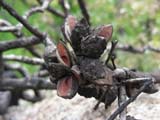
|
Of Fruits and Nuts
The fruit of many forest plants (eg. the eucalypts) are hard and woody,
and highly resistant to burning.
The heat of a fire helps to ripen the seeds inside these fruits, and often
cause the fruit casing to split.
Over the next couple of days, the seeds drop out onto the newly-cleared
soil.
The so-called "honkey nut" of the marri and the large, woody
fruits of the banksias are good examples of fire-resistant fruits. |

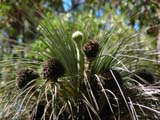
|
Bark - A Coat for All Seasons
Most of the larger forest plants have a thick, protective bark which
will resist all but the fiercest fires.
The eucalypts and casuarinas are good examples of this.
Karri and jarrah trees are among the most fire resistant species in the
world.
The insulating bark of jarrah is effective even against very hot fires.
The common blackboy doesn't have bark in the way other
trees do.
Its trunk is made up of a dense matting of burnt leaf-bases.
After a fire, the new crown grows on top of the burnt remains of the
previous one.
In this way the blackboy increases in height with every burning.
|
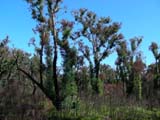
|
Epicormic Buds
Epicormic-buds are special leaf-buds found just under the bark of the
trunk.
Fire damage to the crown stimulates these buds to shoot out from the
bark as clumps of foliage, permitting the tree to carry on with its essential
functions while the crown recovers.
They are most striking in marri and karri, appearing like a lacework
vine climbing up around the trunks.
Rootstock - A Basement Pantry
Many woody-stemmed forest trees have an underground rootstock, or lignotuber,
which will send out new shoots if the old trunk is badly damaged.
These shoots, sometimes called suckers, may in time usurp the old trunk
if it cannot recover.
Otherwise, once the old trunk is functioning sufficiently, the suckers
may deteriorate, die and eventually fall off.
Blackbutt and Jarrahs are vigorous examples of rootstock growers.
|
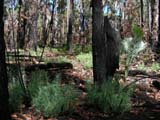
|
The Eternal Seed
The first plants to burn in a fire are those of the undergrowth on the
forest floor.
Consequently, the survival of their species depends totally on the copious
quantities of seeds they produce early on in their life.
These lie dormant on the soil waiting for a fire to clear the ground-cover
and to stimulate their germination.
|
The Eucalypt Forest
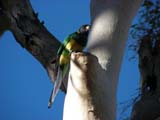
|
THE OVERSTOREY, or forest canopy
In the overstorey are found the seed capsules and fruit of the large
trees, insects of many sorts, and the birds which feed on these foods.
The Port Lincoln Ringneck, or "Twentyeight", which feeds on
the pulp of the green eucalypt fruit, particularly that of marri, can
often be seen in large flocks high up in the tops of the tall forest
trees.
THE MIDSTOREY
In the branches and tops of the karri oaks, peppermints, banksias, and
cedars, birds such as the New Holland Honey-eater and the Western Rosella
feed on the insects and seeds, and the nectar from the flowering trees
and shrubs in the neighbourhood.
|
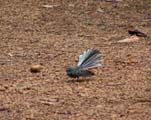
|
THE UNDERSTOREY
Scrubwrens, Robins and the Fairy-wrens flit through the dense scrub,
coming down to the ground in search of food.
THE FOREST FLOOR
The domain of the native mammals and ground dwellers such as the Emu,
the forest floor is only sparsely populated in karri forest.
Most mammals are usually found in the more open jarrah, forest and woodlands.
|
The Trees
|